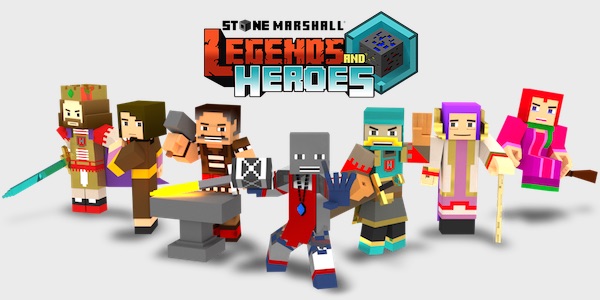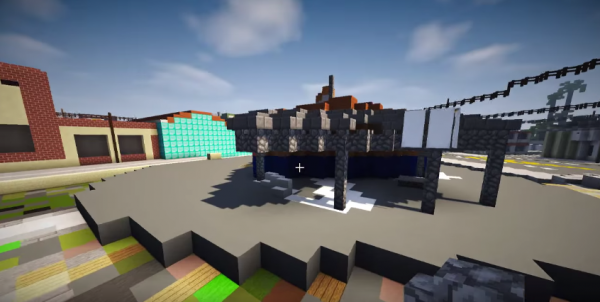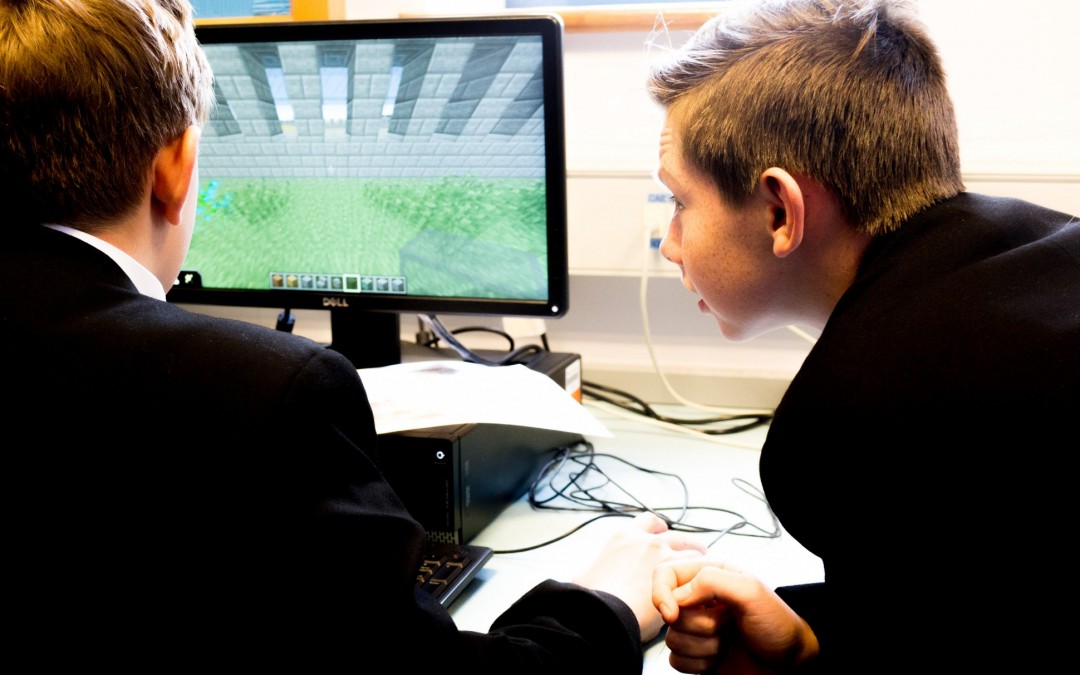
by Stone Marshall | Sep 27, 2015 | Minecraft News |
You have probably heard of Minecraft. It is the most popular video game of all time, played by both kids and adults. It is more than just a game. In fact, because the objectives are user generated, the rules flexible, and the components modifiable, it may not be a game at all. At least not in the structured sense that, say, baseball is a game. Minecraft is more like a platform on which games can be played. Players build, socialize, explore and learn with Minecraft. It is more sandbox than sandlot.
Today’s kids are completely absorbed into the world of Minecraft, and many parents are worried.Where ever I go, moms and dads haphazardly toss around words like “addiction” and “obsession.”
“My kid just watches videos on YouTube all day,” they complain, “or she’s on some server or something, doing whatever it is that they do. I can’t get her to stop!”
I patiently explain that their children are using creative problem solving abilities, number sense, spatial conceptualization, aesthetic sensibility, social-emotional skills, complex imaginative reasoning and more. Additionally, they’re doing all of this in a multiplayer mode that’s sophisticated and collaborative. They’re interacting with kids all over the world, sharing projects and perspectives.
I suspect that these Generation Blockhead Minecraft kids will grow up to change the life-world in ways that we can barely begin to imagine. But they need more guidance and support—less panic and paranoia.

1. Parents Are Over-reacting
Please don’t try to exorcise the game from your kids’ lives like it is some sort of evil satanic temptation. Remember that when parents turn away from their children’s world, children turn away from their parents. Certainly, Generation Blockhead kids shouldn’t play all day; moderation is key. And parents need to teach them reasonable limits. But don’t use the word “addiction” or “obsession.” It just reinforces helplessness, disempowers humanity, and teaches our children to surrender their autonomy to the sensational appeal of digital machines.
Kids need your help learning to manage their time, figuring out how to play responsibly, and understanding how to make meaning out of a complex virtual world. So try playing with them; or just play by yourselves. Download the pocket edition to your smart phone. Ask your kids to explain how it works. Talk to them about the game. When parents take an interest in their children’s world, human progress reaches its apex. One foot stays firmly planted in the mature values of the past, while the other skips youthfully into the technological future.
Kids need your help learning to manage their time, figuring out how to play responsibly, and understanding how to make meaning out of a complex virtual world. So try playing with them; or just play by yourselves. Download the pocket edition to your smart phone. Ask your kids to explain how it works. Talk to them about the game. When parents take an interest in their children’s world, human progress reaches its apex. One foot stays firmly planted in the mature values of the past, while the other skips youthfully into the technological future.
2. Minecraft Belongs In The Classroom
Some adults get it. There are teachers that see the power of Minecraft. They recognize the possibilities. All around the globe, there are classrooms in which MinecraftEDU has become a teaching tool as fundamental as the chalkboard. Using a version specifically designed for the classroom—fitted out with teacher controls—classroom innovators imagine creative activities that take place with students crowded around PCs and tablet computers. They collaborate as a cohort of peers, navigating blockheaded avatars through a user-generated pixelated universe.
In Northern Ireland, in fact, all of the schools use Minecraft. They’ve made a system-wide decision to integrate it into ordinary curricula. I visited classrooms in Derry/Londonderry where students were recreating the country’s landmarks, discussing history, geography, and culture. The kids were engaged and excited. It was precisely the kind of experiential project-based activity that education experts have been praising for decades. The kids weren’t hindered by the limits of life-word space. It didn’t require access to expensive materials and well maintained model-building tools. There was no learning curve to acquire the necessary construction skills. The students just did it. They jumped right in to rigorous hands-on learning.

3. Stop Complaining And Start Embracing
Back in the United States, however, I often meet teachers who protest that their students get enough Minecraft time at home. School, they argue, is a place for pencils and books. To this “sanctity-of-school” argument, I ask, do we make the same school/home division when it comes to literacy, social/emotional skills, science, art, music, math, or conflict resolution? Do we tell them not to use these things at home? Why would we relegate the use of certain tools and proficiencies to one place and not welcome them into another?
Remember, school is not the temple at which we worship the technological landscape of the past. It is a safe space where we teach young people to how to responsibly integrate millennia’s worth of human wisdom and knowledge into current everyday lived experiences. Schools shouldn’t fear technological cross-contamination; they should embrace it. We should encourage Generation Blockhead to practice using philosophy, economics, political science, and engineering on Minecraft servers.
If you talk to grown-up Minecraft fans, you’ll discover that, just like the curmudgeonly teachers, many also object to moving it into schools. For these folks, however, it is all about the sanctity of the video games. “Please don’t educationalize it,” they plead, “school will strip the game of everything that makes it fun.” My heart breaks for these naysayers. Their argument reveals a lot about the miserable experience they must have had in the classroom.
School only feels frustrating to students when academic content is presented for the sake of obedience, rather than empowerment. School should be enjoyable. Arguing that we should divorce creativity and fun from academia—for fear that school will contaminate the purity of play—is absurd. It reinforces the misguided conception of play-as-superficial that’s already threatening to eliminate recess, music, painting, and the performing arts from all non-elite institutions.
Our schools need more playgrounds, not less. More slides. More swing sets. More sandboxes.
4. Sandboxes Once Changed The World
One could argue that sandboxes—the real ones, not the digital kind—were a fundamental part of the social progress that came about during the 20th Century.
You may be surprised to learn that sandboxes have not always been a part of childhood. They are relatively recent, dating back to Friedrich Froebel’s 19th Century Kindergarten movement. Back then, “Sand Bergs” were new features in Germany’s playgrounds and parks. They first showed up in the United States around 1885. Physician Marie Elizabeth Zakrzewska visited Berlin and, upon her return to Massachusetts, reproduced the play spaces at home. They were known as Boston’s “sand gardens.”
These “sand gardens” became so popular, so quickly, that in 1897 child psychologist G. Stanley Hall undertook a focused case study of one such “sand-pile.” It was located in “a quiet community of a few score families of farmers, some twenty or thirty miles from Boston.” Hall wrote an account of his observations entitled: The Story Of A Sand-Pile. In the book, he tells of children building “wells and tunnels; hills and roads like those in town; islands and capes and bays with imagined water” as well as “mines of ore and coal, and quarries of stone, buried to be rediscovered and carted to imaginary markets.”

Of course, there’s nothing particularly profound in realizing just how easily the internet allows us to interact with people around the globe. But when you think of Minecraft as a global sandbox, Generation Blockhead becomes even more amazing.
See, Hall discovered something really important in that sand-pile outside of Boston in the 1890s. He found a community of boys that was not only cultivating an enriched, playful, and adaptive sense of the individual self. They were also, in effect, practicing local civics. They were applying and experimenting with the sorts of individual cognitive skills that we teach in schools. And simultaneously, they were using that academic content, those practical skills, and a unique sense of identity in order to practice being meaningful contributors to a local democratic society.
I suspect that those children eventually grew up into a community that was just as regional as the sand-pile. Today’s students, alternatively, will grow up to discover themselves in a world that demands they participate in a global economy. Our 21st Century children’s civic responsibility, their ability to contribute, and their capacity to collaborate with a diverse group of people, therefore, requires a different kind of sandbox. The internet is rapidly creating communities that transcend geographical limitations. We are no longer tethered to land. Thus, education is now responsible for training workers, cultivating thoughtful individual citizens, and preparing people to live a fulfilled life within the first-ever truly global civilization.
Lucky for us, Minecraft already provides the perfect sandbox, now we just need all of our schools to help kids realize it’s potential.
Everything Teachers, Parents (And Players) Need To Know About ‘Minecraft’

by Stone Marshall | Sep 27, 2015 | Minecraft News |
The second day of this year’s Oculus Connect conference for virtual reality developers kicked off with an announcement-rich keynote presentation. While the event was short on new game announcements, one big one got the crowd’s attention: Minecraft. A brief video confirmed that the hit game’s Windows 10 edition will launch on the Oculus Rift “next year,” and it will allow players to navigate their blocky worlds in VR with the Xbox One controller.
Oculus CEO Brendan Iribe confirmed that the Oculus Touch handheld controller system will launch in the “second quarter next year,” which is a firmer confirmation than a previous “first half of 2016” estimate. After showing off that system’s impressive “toybox” demo, Iribe confirmed that the Touch controllers will require a second motion sensor “for improved sensing,” so be ready to make room in your home’s potential VR room should you want to try the tech out.
The Touch sizzle reel confirmed that a few previously SteamVR exclusive games would now also launch for Oculus Touch, including Job Simulator and The Gallery: Six Elements. It also had Oculus’ own answer to SteamVR’s Tilt Brush, a “digital clay molding” art app called Medium. “Every great platform has to have a paint app, and this is our paint app,” Iribe told the Oculus Connect crowd.
Additionally, Epic Games’ Tim Sweeney took the stage to show off Bullet Train, an upcoming VR action game for Oculus Touch that includes a warping mechanic much like SteamVR’s The Gallery: Six Elements, meaning characters may potentially be able to move around the world without experiencing VR nausea.
Since virtual reality gaming on PCs demands incredibly powerful performance—particularly to support a 90 frames-per-second visual refresh, in order to reduce nausea and discomfort—Oculus announced a new “Oculus Ready” initiative through which computer manufacturers can slap a sticker on a PC that meets Oculus Rift’s performance minimums. Announced partners for the program include Asus, Dell, and Alienware (itself a wholly owned Dell subsidiary).
Oculus wanted the crowd to know that there’s no shortage of interested Oculus developers, so they took the opportunity to announce that “over 200,000” developers had registered to create games for the new VR platform. The company announced that those developers will see version 1.0 of the Oculus Rift SDK in “December,” ahead of the headset’s launch early next year.
The keynote began with Samsung Senior Vice President Peter Koo announcing an updated GearVR headset coming in November for $99. Like the prior “innovator edition” of GearVR, this will allow users to insert certain Samsung phones into a wearable headset to experience a more rudimentary version of virtual reality. That announcement also touched upon virtual-reality versions of video-streaming apps like Netflix and Hulu coming to GearVR “in the next few months.”
VR Minecraft announced for 2016 at Oculus Connect conference
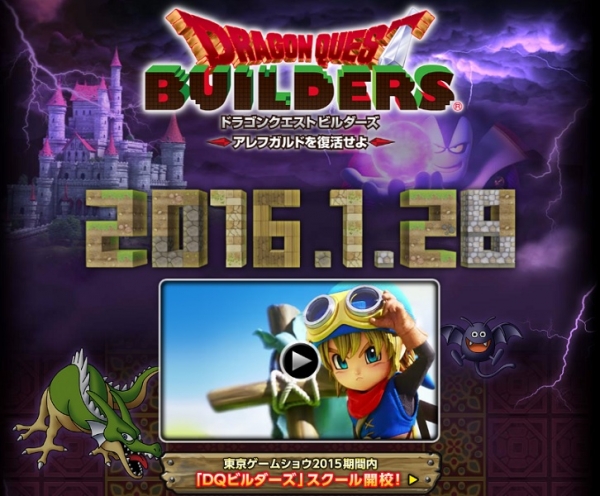
by Stone Marshall | Sep 25, 2015 | Minecraft News |
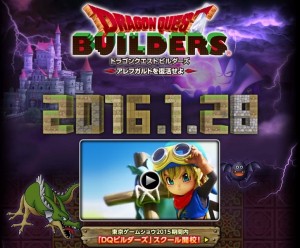
Square Enix introduced Dragon Quest Builders in demo mode at TGS 2015, and it was full of surprises. Even if it made consistent efforts to polish its looks and add new elements, the game still shows its heritage.
Minecraft is the first thing that comes to mind when starting to play Dragon Quest Builders, but until the latter becomes a true rival for the Mojang and 4J Studios’ creation, some improvements are mandatory.
Common elements are easily discernable, the inventory bar being the first that pops out. Also, there is an equipment belt where you can holster various weapons and tools, and you can browse through it by pressing up/down on the D-pad. To dig, you generally use the hammer just as in the trailer of the game.
If you believe all actions are intuitive, think again. Even for such an elementary task as digging, gamers should know that a simple attack/dig (square button) only hits objects positioned on the same level as you. L1 and R1 buttons allow you to aim the hammer at block situated higher or lower than you, whereas if you want to aim and hit enemies or blocks that are above or below, the shoulder buttons do the trick. Speaking of digging, the demo limits the vertical mobility to about four levels downward and 40 levels upward, making it way less open world than its predecessors.
Moving on to the unique aspects of the game, the general visuals are cute and stay true to the Dragon Quest spirit. Moving around and performing actions feels flawless. As opposed to Minecraft’s “jump in the water and learn to swim” approach, Dragon Quest Builders has a soft learning curve due to its schematic system that shows you how to easily build stuff. An interesting addition is that the settlements that you construct will gradually attract NPCs.
The gameplay would benefit from a first-person mode. From the fiddling with the controls in third-person, it is blatantly clear that for precise aiming and efficient working in closed spaces, first-person is paramount.
Developers announced that the game will feature a story mode and a campaign objective, but it’s the players’ choice how and when it accomplishes them. Building your cube-spaced-world can continue indefinitely after the ultimate boss fight. However, for those who only desire to share their creations with the community, a pacifistic mode will be available.
The demo offers only a fraction of the game’s full potential. Some gameplay adjustments and a couple novel elements might help the open-world RPG construction game depart from the nagging comparisons with Minecraft.
On Jan. 28, 2016, Dragon Quest Builders will be released in Japan on the PS4, PS3, and PS Vita. For now, there is no information about an international launch.
Dragon Quest Builders: Minecraft Clone Or Is It Much More? Release Date Revealed





